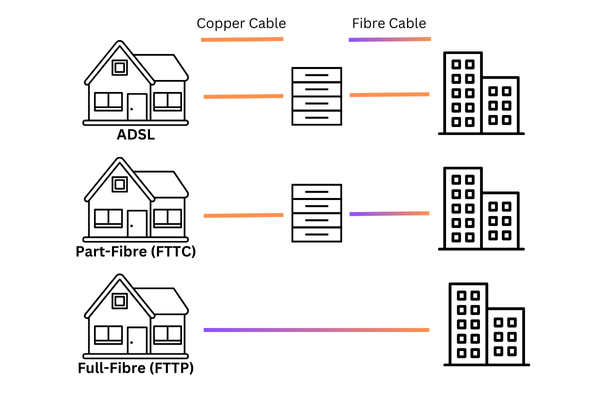
Have you seen the terms ‘FTTP’ and ‘FTTC’ when looking at your fibre broadband options and wondered what they mean? Confused about which broadband connection is best for your needs?
They can sound intimidating at first, especially if technology isn't your forte. But behind the jargon, the choice is pretty simple.
Whether you’re planning to upgrade your home broadband or business broadband speeds, Broadband Genie is here to help.
By the end of this page, you’ll understand exactly what FTTC and FTTP mean and, most importantly, which type of internet connection is right for you.
What is FTTC broadband?
FTTC stands for ‘Fibre to the Cabinet’. Fibre optic cables run from the local exchange to a green street cabinet you will have walked past on pavements in the UK.
From there, your home is connected using your existing copper phone lines to complete the circuit. These connections are sometimes referred to as ‘part-fibre’.
The downside with FTTC is that copper isn’t great at carrying data over long distances. The further your house is from the cabinet, the slower it is.
Usually, FTTC broadband gives you download speeds somewhere between 40Mb - 80Mb.
That’s fine for everyday tasks like browsing the web, checking emails, watching YouTube or doing a bit of online shopping.
However, as these telephone lines in the UK are due to be switched off in a couple of years, more homes are being encouraged to switch over to full fibre (FTTP).
If you only have access to FTTC broadband for now, it should be plenty fast enough for most tasks. But if you do have access to full fibre (FTTP), now is a great time to future-proof yourself and make the switch.

What is FTTP broadband?
FTTP stands for Fibre to the Premises. Fibre optic cables run directly from the service provider’s network into your home or office.
Fibre optic cables are designed to carry large amounts of data quickly.
That’s why FTTP can offer incredibly fast speeds. It’s also called full fibre broadband because there’s no copper in the internet connection at all.
The result is a more reliable, consistent internet.
FTTP is great for HD or 4K video streaming, large file downloads, remote working, and households with lots of devices online at once.
If you have a busy household, work from home, stream a lot or enjoy online gaming, this is the connection for you.
FTTC vs FTTP: what’s the difference?
The main difference between FTTC and FTTP is the inclusion of copper cable in the mix.
Here’s a quick look at how FTTC and FTTP compare side by side:
Part-Fibre / FTTC (Fibre to the Cabinet)
- Fibre runs to your street cabinet only
- Final connection uses copper wiring
- Maximum download speeds are around 80 Mbps
- Performance can vary depending on distance
Full Fibre / FTTP (Fibre to the Premises)
- Fibre runs directly into your home, or office
- Fast broadband speeds of 1Gb+
- Very stable and consistent performance
- Typically costs more than FTTC
Which connection is better for you?
Choosing between FTTC and FTTP depends on availability, how you use the internet and your budget.
FTTC could work well if:
- You’re not a heavy internet user: Things like browsing, watching videos, and online shopping are all fine on FTTC.
- You’re on a budget: FTTC plans usually cost less per month.
- FTTP isn’t available yet: FTTC is more widely available across the UK for now.
FTTP might be a better fit if:
- You need high-speed internet: FTTP is better for streaming, gaming, or multiple people working online at the same time.
- You work from home or run a business: A fast, reliable connection is important for video calls, file sharing, and working online.
- You want long-term value: FTTP is built to handle the internet demands of the future.
When will I get FTTP?
FTTP has been around for a while but is still being rolled out across the UK. Many cities and larger towns already have it, while rural areas may be waiting a bit longer.
Providers like BT, Virgin Media, and CityFibre are steadily expanding their full fibre networks.
It’s an expensive process that involves a lot of work, including digging up streets, upgrading exchanges and replacing old copper wires with fibre. But this should be completed by January 2027 as the UK works towards shutting down traditional phone lines.
For more information on where to look visit our page: ‘Fibre in my area: check if you can get fibre now’.
Who offers full fibre broadband (FTTP)?
You now have more choice of full fibre providers than every before.
These include:
BT Openreach
BT Openreach has the largest FTTP network, with over 4.7 million homes having access to full fibre broadband, with average download speeds up to 900Mb.
Providers on the Openreach network include BT, Vodafone, Sky, Plusnet and NOW Broadband.
Learn more: 'What is Openreach?'
Hyperoptic
Hyperoptic runs its own full fibre network, which offers speeds up to 1Gb, although slower (and cheaper) packages are also available. Coverage is limited in comparison to other providers, but it’s excellent value for money if you can get it. Hyperoptic currently serves larger towns and cities and is often installed in new-build flats.
Gigaclear
Gigaclear runs its own network and is committed to upgrading rural communications to give them access to full fibre connections. It gives vital ultrafast speeds to villages and smaller towns across the UK.
FTTC and FTTP FAQs
-
What is FTTP, and how is it different from FTTC?
FTTP (Fibre to the Premises) uses fibre cables all the way into your home.
FTTC (Fibre to the Cabinet) uses fibre to the street cabinet, then copper to your home.FTTP = full fibre = faster speeds and more reliable
FTTC = part fibre, part copper = decent but slower
-
Can I upgrade from FTTC to FTTP?
Yes, you can upgrade from FTTC to FTTP, but only if FTTP is available where you live. If your area has been upgraded, switching is usually straightforward.
Here’s what to do if you're thinking about upgrading:
Check availability – Use the Broadband Genie postcode checker to see what’s available.
Compare FTTP packages – Different providers offer different speeds and prices.
Schedule an installation – Your new provider will handle the switch. They’ll arrange for an engineer to install the fibre if required and set up your new connection.
Find out more in our guide: 'How to switch broadband provider'.
-
Is FTTP worth it?
It depends on how you use the internet:
FTTP is great if you:
* Have lots of devices online
* Work from home or run a business
FTTP might not be worth it if:
* You mostly browse, stream occasionally, or check email
* You’re on a tight budget
* FTTP isn’t available in your area yet
* Want fewer dropouts and better speeds
* Plan to stay in your home long-term
-
How do I know what type of broadband I have?
Check your provider’s emails or online account – Most broadband providers mention your connection type. Look for terms like “Fibre to the Cabinet (FTTC)” or “Full Fibre / FTTP” in your welcome email, bills, or online account.
Use a postcode checker – The Broadband Genie postcode checker or Openreach Fibre Checker can show what services are available and what’s likely installed at your address.
Look at your speeds – 30–80 Mbps = likely FTTC, 100 Mbps+ = probably FTTP.
Ask your provider – a quick call or live chat will clear it up.
Check your setup – FTTC and ADSL broadband uses a standard phone socket; FTTP usually has a powered wall unit and a different type of router.
Summary: FTTP vs FTTC at a glance
Both full fibre (FTTP) and part-fibre (FTTC) deals can provide fast fibre broadband at affordable prices.
Both work slightly differently, but:
FTTC is great if your internet needs are more basic, or if FTTP just isn’t available where you live.
Choose FTTP if you want fast, reliable broadband that can support many smart devices and future needs.
The type of broadband you have can shape your daily routine. This includes the kind of shows you can stream without buffering, how smooth your video calls are, and how efficiently you can work from home.
Check what’s available in your area, compare a few providers, and go with the option that makes the most sense for your budget and how you use the internet now and in the future.
To help you understand what broadband speed you need for your home, read our ‘Ultimate Guide to Broadband Speeds’.
Still unsure which broadband is right for you?
Choosing between FTTC and FTTP is a lot easier when you know what’s available at your address.
Use the Broadband Genie postcode checker to quickly see your choice of best broadband deals.
Compare speeds, prices, and providers in seconds – and find the right fit for your home and budget. Try it now!